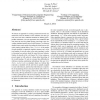Free Online Productivity Tools
i2Speak
i2Symbol
i2OCR
iTex2Img
iWeb2Print
iWeb2Shot
i2Type
iPdf2Split
iPdf2Merge
i2Bopomofo
i2Arabic
i2Style
i2Image
i2PDF
iLatex2Rtf
Sci2ools
PADS
2004
ACM
2004
ACM
Space-Parallel Network Simulations Using Ghosts
We discuss an approach for creating a federated network simulation that eases the burdens on the simulator user that typically arise from more traditional methods for defining space– parallel simulations. Previous approaches have difficulties that arise from the need for global topology knowledge when forwarding simulated packets between the federates. In all but the simplest cases, proper packet forwarding decisions between federates requires routing tables of size O(mn) (m is the number of nodes modeled in a particular simulator instance, and n is the total number of network nodes in the entire topology) in order to determine how packets should be routed between federates. Further, the benefits of the well–known NIx-Vector routing approach cannot be fully achieved without global knowledge of the overall topology. We seek to overcome these difficulties by utilizing a topology partitioning methodology that uses Ghost Nodes. A ghost node is a simulator object in a federate that...
| Added | 30 Jun 2010 |
| Updated | 30 Jun 2010 |
| Type | Conference |
| Year | 2004 |
| Where | PADS |
| Authors | George F. Riley, Talal M. Jaafar, Richard M. Fujimoto, Mostafa H. Ammar |
Comments (0)

